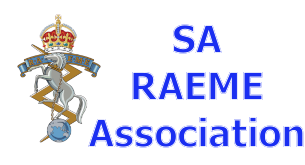General
9. Incidentally the role of the present day Royal Australian Electrical and Mechanical Engineers was carried out, at least in part, by the Colonial Storekeeper, then by the self contained portion of the South Australian Military Forces or the Commissariat part of the Government Stores which originally functioned near Pirie Street, ADELAIDE, and later in North Terrace East. A Government Gazette of 21 February 1956 shows an order for weapons etc., to be returned to stores at the Mounted Police Barracks, North Terrace, ADELAIDE.
10. In 1847, #940 was spent in converting the Destitute Asylum Buildings into a Military Barracks. The conversion included an armoury and barracks store room gun sheds. These buildings were in use as an armoury with a military storeman until 1913, then continued to be used up to 1920 for other military purposes.
11. A Government Gazette of 27 January 1859 published a list of expenditures for the year 1858. This list included a fixed establishment for a Sergeant Armourer with a salary of #187.8.6 and $32.2.2 allowances. His task was to carry out repairs to Army equipments,authorise contracts for repair to civilian contractors and be responsible for the standard of workmanship and material used in such contracts. This practice is still carried out by the Royal Australian Electrical and Mechanical Engineers Trade Repair Section.
12. The following is a typical example of the format used when calling for tenders for repair:
Government Gazette of March 8, 1860
Chief Secretary's Office, March 6, 1860.
Tenders for the repair of sixty two Ordnance carriage wheels will be received at this office until Wednesday the 14th instant at noon. Particulars can be obtained on application to the Sergeant Armourer, Armoury, North Terrace.
Wm Younghusband
Chief Secretary
13. The volunteer military force reached approximately 2,000 men by 1860. This greatly increased the work load of repairs, therefore, as indicated in the Almanac for the year 1866, the repair staff was increased by a Repairer of Arms H. DAVIES.
14. The only indication of the site where repairs were carried out is that, in 1868, a workshop of 20' x 28' formed portion of a building which also housed a store, two chaff rooms and a lumber room with storekeeper's quarters and commissariat in the same building.
15. Parliamentary Paper 112 of 1887 shows that Brigadier General OWEN stated that he had 5,000 Martini Henry rifles. At that time, according to Captain de BURGH, Staff Captain South Australian Defence Force, men paid for the repair of their riles and the Armourer who carried out the repairs was paid #150 per annum.
16. At about that time the Military Forces became a separate department, with Captain de BURGH as Military Storekeeper, assisted by an Armourer. These appointments appear under the heading of arms, ammunition, accoutrements and camp equipment. Parliamentary Paper 112 of 1887 paragraph 974 states that: we have two storemen, one of whom is employed in the Armoury, is a skilled workman able to assist in 'browning' and in other things .
17. At this stage tradesmen began to appear and were formed into a workshop section which was the forerunner of the Australian Army Ordnance Corps (Permanent) and ultimately Royal Australian Electrical and Mechanical Engineers. Rates of pay were shown in Blue Book 1899 as follows:
- Conductor of Stores 170.
- Armourer Sergeant Major 160.
- Sergeant Major Armament Artificer 150.
18. With the re organisation of the repair side of the military forces, duties became more detailed, eg:
General Order 1903 paragraph 262 Saturday14th November 1903
Any repairs beyond the capabilities of the Permanent Warrant Officer or Staff Sergeant will be carried out by the Armourer Branch of the Ordnance Depot. Permanent Warrant Officers and Staff Sergeants of the Army Instruction Corps attached to units will examine all small arms once a year, and on behalf of the Armourer Section render a report through the Command Office of the Regiment for transmission to the Senior Ordnance Officer in the state .
Military Order 108 1907
The inspector of Ordnance Machinery will be available for expert duty with the Military Board and the Commandants of the several districts. All reports will pass direct between the officers concerned.
Discipline
The inspector of Ordnance Machinery will be officer commanding the Armament Artificers of the Commonwealth Military Forces and exercise all Military powers as prescribed in Regulations for the Commonwealth Military Forces .
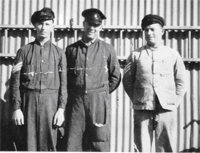 19. Photograph 1, taken in 1930, shows a tradesman, Sgt. R. REYONLDS (right) and two coast artillery soldiers.
19. Photograph 1, taken in 1930, shows a tradesman, Sgt. R. REYONLDS (right) and two coast artillery soldiers.
20. They are standing against the wall of one of the first workshop buildings in SOUTH AUSTRALIA. This building was approximately 500 square feet in area and was known as the Artificer Workshop, FORT LARGS. It contained a treadle lathe, a drill, a forge and benches and was erected in 1920. The establishment of 10 Heavy Battery Royal Australian Artillery in accordance with Australian Army Order number 47 26 1 29 included three staff sergeants, afarrier, a saddler and an Artificer Artillery. The Artificer Artillery, named S. REEVES, set up the workshop component at FORT LARGS.
21. Prior to this, in approximately 1912, District Headquarters Ordnance and the workshop from the Destitute Asylum Building in North Terrace transferred to a new site and buildings at KESWICK, about one mile South West of the City of ADELAIDE. The Ordnance staff then comprised the chief ordnance officer, 5 clerks, 10 storemen and tradesmen, and 4 artificers. These positions later changed to civilians.
22. Workshop buildings in the KESWICK area from 1920 included the following:
- General Engineering shop 1500 sq ft
- Carpenter's shop 600 sq ft
- Instrument shop 200 sq ft
- Blacksmith's shop 600 sq ft
- Mess room and office area 400 sq ft
- Textile and saddlery shop 1200 sq ft
- Armoury 2000 sq ft
- Zeroing range 1400 sq ft
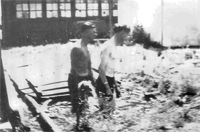 23. Photograph No 2 taken in 1938 shows Craftsman (now Lieutenant) HEFFERNAN and Corporal CHENOWETH standing in the old well in the original Workshop Buildings at KESWICK. This well was used for shrinking steel tyres on wooden wheels and is 9 feet diameter and 2 feet deep. The furnace used in the manufacture of the steel tyres was in the white building shown in the photograph.
23. Photograph No 2 taken in 1938 shows Craftsman (now Lieutenant) HEFFERNAN and Corporal CHENOWETH standing in the old well in the original Workshop Buildings at KESWICK. This well was used for shrinking steel tyres on wooden wheels and is 9 feet diameter and 2 feet deep. The furnace used in the manufacture of the steel tyres was in the white building shown in the photograph.
24. About 1918 the Field Brigade was issued with 18 pounder Mark I and II artillery and 4.5 Howitzers. These equipments had oil, air and spring recoil systems. This gave an increased work load to the workshop who were now responsible for repair, modification, inspection and preparation for firing practice. Prior to this the weapons were in a 'drill only' condition.
25. About 30 miles East of ADELAIDE in the WOODSIDE Army Camp was a workshop of 1500 square feet. In this workshop repairs were carried out and equipment served during militia camps. Remount farms were situated atO'HALLORAN'S HILL and at ELDERSLIE, which was East of WOODSIDE; these farms were visited by tradesmen periodically, to repair equipment such as carts, wagons, limbers and various farming equipment, in situation. WOODSIDE workshop was also used to train enlistees during the formation of units for the AIF in 1939.
26. During 1919 two BL 6 Mark 7 Guns Coastal Artillery were installed at FORT LARGS to replace the 'disappearing' guns, and an artificer was continuously in attendance to maintain them. The BL 6 in guns had in fact been installed in 1906. They were sent to MARIBYRNONG to be milled and lapped in 1929. Electrical instruments with wiring from the gun floor, a depression range finder, automatic sights, range and bearing equipments were all the responsibility of the artificer, in that he had to install, replace and adjust these technical equipments. The artificer was Armament Sergeant Major of the workshop in 1920. This artificer had war service in the 1914 1918 was in a Base Workshop in FRANCE.
27. Motor Transport was introduced in 4th District Base about 1921. Minor repairs to transport were carried out by 'trade repair' and controlled by the Armament Sergeant Major of the workshop. A system of inspection was introduced and published in Australian Army Order on 31 January 1920. The following is a copy of the order:
Q39. Inspection of Motor Vehicles.
1. All Motor Transport vehicles will receive periodical inspections as follows:
- Annual, by Ordnance Department
- Quarterly, by Ordnance Department
- Monthly, by Officer in Charge Transport or his staff.
2. The annual inspection by the Ordnance Mechanical Engineer, or his representative, will take place of one quarterly inspection.
3. The quarterly inspection refers to that mentioned in paragraph 2 of Military Board Instruction Q.22/1928, and will be a technical inspection carried out under local arrangements.
4. The monthly inspection by the Officer in Charge of Transport will be carried out in conjunction with the check of tools and equipment mentioned in paragraph 6 of Military Board Instruction Q.221928. This inspection will be made with the object of ensuring that vehicles are in a satisfactory running condition. It will also serve to bring to light defects requiring immediate attention.
5. Australian Army Form G24 will be used to record Annual and Quarterly Inspections. Applications for such inspections will be made by the Officer in Charge Transport to the Chief Ordnance Officer concerned. One copy of Australian Army Form G4 will be filed in the Vehicle Log Sheet File (Army Book 5).
This form will not be used for monthly inspections, which will be recorded on the Monthly Vehicle Log Sheet, together with any action taken, and initialled by the Officer in Charge Transport .
28. 4 District Base Workshop had two vehicles at about this time. They were a 1920 model Morris Cowley buckboard and a 1920 Thonycroft truck.
29. The Morris in particular was a great value in moving tradesmen and their tools from the workshop at KESWICK to LARGS BAY and other places where work in situation was to be done. Prior to obtaining this transport, when a tradesman was required to move toLARGS BAY from KESWICK, he collected his tool box and set off, first by catching a tram car in front of where the Regimental Aid Post now stands at KESWICK. This tram car took him to the ADELAIDE station, where he caught a train to DRAPER. He then walked from DRAPER to LARGS BAY, a distance of about 1 1/2 miles, carrying his tool kit all the way. On completion of his task he returned to KESWICK in the same manner.
30. Following the suspension of compulsory military training in 1929, Army equipments were treated with preservatives and stored in the Ordnance Depots. Then came the 'depression', and a heavy cut in the defence vote with a resultant heavy reduction in Army staffs. Repairs, modifications and inspections were stopped, with the exception that a limited amount of repair work was carried out on equipments for use at Annual Military Camps.
31. The Proof and Experimental Establishment was established at PORT WAKEFIELD to proof ammunition between 1926 and 1929. First rounds were fired 4 December 1929. Included in this establishment was a workshop of 1600 square feet in area, for use in the repair and preparation of guns for firing. Repairs and preparation were carried out by the tradesmen of Proof and Experimental Establishment, but artificers from 4 District Base Workshop attended all firing practices. Some of the earliest artificers carrying out this task were Warrant Officer REEVES, Sergeant OAKES (now Captain OAKES), and Artisan REYNOLDS (now Warrant Officer Class 1 REYNOLDS).
32. Photograph No 3 shows a QF18 PR Mk II being repaired by Corporal CHENOWETH and Sergeant REYNOLDS; Photograph No 4 a QF18 PR Mk IV mounted on a Mk III carriage; and Photograph No 5 a BL 60 PR respectively and the artificer at the Proof and Experiment Establishment, 1937. These weapons were used in ammunition proofing.
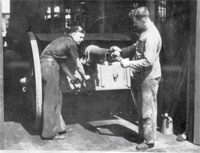 Corporal CHENOWETH and Sergeant REYNOLDS |
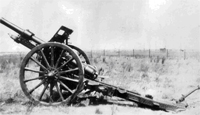 QF18 Pounder Mk 4 on a Mk 3 Carriage |
 Breech Loading 60 Pounder |
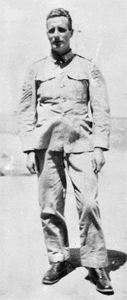 Artificer (now Captain) OAKES |
33. During the period 1928 1929 approval was given for the following:
- The addition of certain military officers with engineering qualifications to the Australian Army Ordnance Depot.
- The formation of Militia Stores Companies to be known as the Australian Army Ordnance Corps Militia.
- The formation of a Military Corps of Armament Artificers which was designated in 1928 as the Australian Army Ordnance Corps (Permanent) and was the forerunner of the Corps of Electrical and Mechanical Engineers which was established later in 1942.
- A Director of Ordnance Services was appointed in 1929 and was the head of the Australian Army Ordnance Corps. This position was responsible to the Quartermaster General until the outbreak of World War II.
34. The rates of pay for members of the Australian Army Ordnance Corps (Permanent) in 1929 were as follows:
Senior Armament Artificers 7 - 5 - 0 to 8 - 0 - 0 per week
Armament Artificers 5 - 13 - 0 to 6 - 5 - 6 per week
35. The Proof and Experimental Establishment at PORT WAKEFIELD continued to expand. This necessitated a greater requirement for the attendance of artificers at the establishment. Militia Camps also placed a further drain on the slender establishments of the Australian Army Ordnance Corps (Permanent). The existing establishments of all Australian Army Ordnance Corps (Permanent) units is detailed in Table 11 of Australian Army Orders of 1932 shown hereunder:
AUSTRALIAN ARMY ORDNANCE CORPS (PERMANENT)
|
Detail |
COME |
OME |
A/OME |
Armt Artificer |
Asst Armt Artificer |
Total |
||||||
|
MAJ |
CAPT |
LT |
QrMr |
Armt SM WO1 |
Armt QMS WO2 |
Armt S/SGT |
SGT |
L/SGT |
CPL |
PTE |
||
|
AHQ |
1 |
|
|
|
|
|
|
|
|
|
|
1 |
|
1 DB |
|
|
|
|
1 |
1 |
1 |
1 |
1 |
|
|
5 |
|
2 DB |
|
1 |
|
1 |
1 |
6 |
1 |
|
1 |
1 |
2 |
14 |
|
3 DB |
|
1 |
1 |
|
1 |
7 |
|
1 |
3 |
1 |
1 |
16 |
|
4 DB |
|
|
|
|
1 |
1 |
|
1 |
|
|
|
3 |
|
5 DB |
|
|
|
|
1 |
1 |
|
1 |
|
|
|
3 |
|
6 DB |
|
|
|
|
1 |
1 |
|
|
|
|
1 |
3 |
|
Total |
1 |
2 |
1 |
1 |
6 |
17 |
2 |
4 |
5 |
2 |
3 |
45 |
36. These establishments did not include civilians, who were employed as textile workers, saddlers, armourers, blacksmiths, carpenters and wheelwrights. With the formation of Australian Army Ordnance Corps (Permanent), it was necessary to set out conditions and requirements for tradesmen to enlist in this corps; they were as follows:
- Applicants must have served at least 5 years as an apprentice to their trade.
- They must pass entrance examinations in Mathematics, Engineering and Drawing and be of a satisfactory medical standard.
37. Applicants having proved themselves suitable for enlistment were then:
- Given three months probation.
- Given a trade test which lasted at least three days.
38. After completion of this, recruits were given three months recruit training at QUEENSCLIFF in VICTORIA or SOUTH HEAD in SYDNEY. They were then enlisted as Corporal Artisans Group 1.
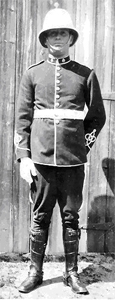 39. The photograph shown here is Artisan REYNOLDS Australian Army Ordnance Corps (Permanent) from 4th District Base Workshop, in Ceremonial Dress.
39. The photograph shown here is Artisan REYNOLDS Australian Army Ordnance Corps (Permanent) from 4th District Base Workshop, in Ceremonial Dress.
40. In 1938, a major overhaul of the two BL 6" Mk VII Coastal Guns at FORT LARGS was carried out. 20 26 Band 27B Cams were also fitted to the Automatic Sights to accommodate the latest type ammunition. Major tools were of an old pattern and were badly worn; however, the experience and training of the tradesmen was of such a high calibre that these tasks were satisfactorily completed.
41. As a further indication of the high class of workmanship required by the Australian Army Ordnance Corps (Permanent), QF18 PR were converted to operate pneumatically as were the 4.5 Howitzers of the 13 Field Brigade and the 48 Field Battery, together with the reserve stocks held by the Ordnance Depot.
42. Very little work on instruments was being carried out in 4th Military District, so in order to ascertain the condition of these, a Lieutenant McFAYDEN was sent from VICTORIA to inspect all instruments held in 4th Military District. He found them to be in bad condition and instigated their overhaul.
43. 4th Military District Workshop had not been designed for the repair of motor transport; this now became imperative. In order to cope with these repairs, Warrant Officer A. A. CRAGO set up a Motor Transport Repair section at the WAYVILLEShowgrounds.
44. Australian Army Order No 28 Table 12 1938 listed the establishment as follows:
- WO1 Artificer - 1
- Staff Sergeant Armament Artificer - 1
- Group 1 Sergeant Artisan - 11
- Group 1 Corporal Artisan - 11
- Group 2 Corporal Artisan - 11
- Workshop Assistant - 1
Ancillary tradesmen were civilians and are not shown.
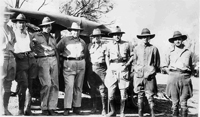 45. The photograph to the right shows members of this establishment. From left to right:
45. The photograph to the right shows members of this establishment. From left to right:
Sergeant R.J. OAKES
Corporal L.CHENOWETH
Staff Sergeant A.L. GANNON
Brigadier MARTIN
Commander 4th Military District
Armament Sergeant Major S. REEVES
Lieutenant G. HAYMAN
Ordnance Mechanical Engineer Southern Command
Lance Corporal HEFFERNAN
Corporal R.W. REYNOLDS
46. A further Australian Army Ordnance Corps installation was a Militia Drill Hall Australian Army Ordnance Corps (Militia) of 5,000 square feet.
47. The mobilisation orders 1938 for Australian Army Ordnance Corps (Militia) units in 4 Military District were:
- Workshop Company V/1937/105/1
- Recovery Section III/1937/55/1
- 19 Light Aid Detachment III/1937/53/1
- 20 Light Aid Detachment III/1937/53/1
48. These orders contained the following information:
Personnel required on mobilisation will be found from Australian Army Ordnance Corps (Permanent), Australian Army Ordnance Corps (Militia), and Australian Army Ordnance Depot, the whole to become Australian Army Ordnance Corps. The remainder of the personnel required will be obtained by recruiting from various military depots, especially the Australian Army Ordnance Corps. The recruiting depot was situated in the Engineers Drill Hall at KESWICK.
Allotment of Australian Army Ordnance Corps (Permanent) and Australian Army Ordnance Depot Personnel.
One artificer and assistant Australian Army Ordnance Corps (Permanent) attached to 10 Heavy Battery LARGS BAY.
Officers Commanding Army Field Workshop and District Ordnance Workshop will be responsible for the preparation and execution of the detailed syllabus.
(a) Armament Repairs
It will be essential to institute detailed instruction on the construction, working adjustment, maintenance and repairs of all sources of equipment as soon as possible.
Regular Artificers of Artillery units should be attached to Army Field Workshops for the duration of the instruction on the equipments with which they are concerned.
(b) Army Field Workshops First Line Repairs
Personnel allotted to this work will be trained and experienced, with exception of Army fighting vehicles.
(c) Instruments and Signals
Optical and electrical instruments repairs must be instituted.
(d) Recovery Section
The syllabus will include instruction in inspection and repair for all types of equipment.
4th Military District on Mobilisation
1 x Ordnance Mechanical Engineer for 4th Military District Deputy Assistant Director Ordnance Services Staff.
4th Military District Workshop
1 x Ordnance Mechanical Engineer (later Deputy Assistant Director Electrical and Mechanical Engineers).
1 x Clerical
5 x Trades staff
4 x Armoury staff
Peace and War Establishments and Increases
|
Unit |
Peace Establishment |
War Establishment |
Increase |
|||
|
Offrs |
ORs |
Offrs |
ORs |
Offrs |
ORs |
|
|
4 District Wksp Coy |
2 |
17 |
1 |
24 |
-1 |
7 |
|
Recovery Section 4 Army Fd Wksp |
2 |
15 |
2 |
67 |
0 |
52 |
|
19 LAD |
1 |
12 |
1 |
12 |
0 |
0 |
|
20 LAD |
0 |
0 |
1 |
12 |
1 |
12 |
